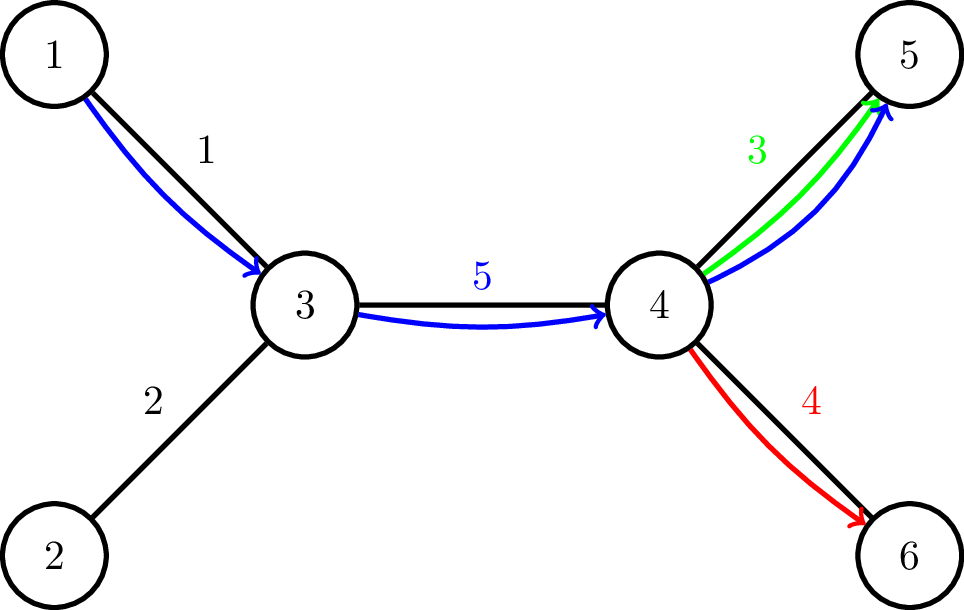CF1628E.Groceries in Meteor Town
普及/提高-
通过率:0%
AC君温馨提醒
该题目为【codeforces】题库的题目,您提交的代码将被提交至codeforces进行远程评测,并由ACGO抓取测评结果后进行展示。由于远程测评的测评机由其他平台提供,我们无法保证该服务的稳定性,若提交后无反应,请等待一段时间后再进行重试。
题目描述
Mihai lives in a town where meteor storms are a common problem. It's annoying, because Mihai has to buy groceries sometimes, and getting hit by meteors isn't fun. Therefore, we ask you to find the most dangerous way to buy groceries so that we can trick him to go there.
The town has n buildings numbered from 1 to n . Some buildings have roads between them, and there is exactly 1 simple path from any building to any other building. Each road has a certain meteor danger level. The buildings all have grocery stores, but Mihai only cares about the open ones, of course. Initially, all the grocery stores are closed.
You are given q queries of three types:
- Given the integers l and r , the buildings numbered from l to r open their grocery stores (nothing happens to buildings in the range that already have an open grocery store).
- Given the integers l and r , the buildings numbered from l to r close their grocery stores (nothing happens to buildings in the range that didn't have an open grocery store).
- Given the integer x , find the maximum meteor danger level on the simple path from x to any open grocery store, or −1 if there is no edge on any simple path to an open store.
输入格式
The first line contains the two integers n and q ( 2≤n,q≤3⋅105 ).
Then follows n−1 lines, the i -th of which containing the integers ui , vi , and wi ( 1≤ui,vi≤n,1≤wi≤109 ) meaning there is two way road between building ui and vi with meteor danger level wi .
It is guaranteed that the given edges form a tree.
Then follows q lines, the j -th of which begin with the integer tj ( 1≤tj≤3 ), meaning the j -th query is of the tj -th type.
If tj is 1 or 2 the rest of the line contains the integers lj and rj ( 1≤lj≤rj≤n ).
If tj is 3 the rest of the line contains the integer xj ( 1≤xj≤n ).
输出格式
For each query of the 3 rd type ( tj=3 ), output the maximum meteor danger level that is on some edge on the simple path from xj to some open store, or −1 if there is no such edge.
输入输出样例
输入#1
6 9 1 3 1 2 3 2 4 5 3 4 6 4 3 4 5 3 1 1 1 1 3 1 2 1 1 1 5 6 3 4 2 6 6 3 4 3 1
输出#1
-1 -1 4 3 5
说明/提示

This is an illustration of the town given in the sample input.
In the first query, there are no open stores, so obviously there are no edges on the simple path from 1 to any open store, so the answer is −1 .
After the second and third queries, the set of open stores is {1} . The simple path from 1 to 1 has no edges, so the answer for the 3 rd query is −1 .
After the fourth query, there are no open stores.
After the fifth and sixth queries, the set of open stores is {5,6} . In the sixth query, there are two paths from xj=4 to some open grocery store: 4 to 5 and 4 to 6 . The biggest meteor danger is found on the edge from 4 to 6 , so the answer for the 6 th query is 4 . This path is marked with red in the illustration.
After the rest of the queries, the set of open stores is {5} . In the eighth query, the only path from xj=4 to an open store is from 4 to 5 , and the maximum weight on that path is 3 . This path is marked with green in the illustration.
In the ninth query, the only path from xj=1 to an open store is from 1 to 5 , and the maximum weight on that path is 5 . This path is marked with blue in the illustration.